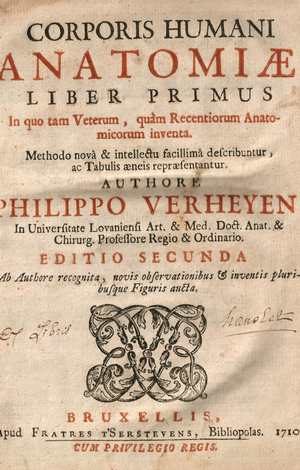
Medical Terminology Daily (MTD) is a blog sponsored by Clinical Anatomy Associates, Inc. as a service to the medical community. We post anatomical, medical or surgical terms, their meaning and usage, as well as biographical notes on anatomists, surgeons, and researchers through the ages. Be warned that some of the images used depict human anatomical specimens.
You are welcome to submit questions and suggestions using our "Contact Us" form. The information on this blog follows the terms on our "Privacy and Security Statement" and cannot be construed as medical guidance or instructions for treatment.
We have 987 guests online

Georg Eduard Von Rindfleisch
(1836 – 1908)
German pathologist and histologist of Bavarian nobility ancestry. Rindfleisch studied medicine in Würzburg, Berlin, and Heidelberg, earning his MD in 1859 with the thesis “De Vasorum Genesi” (on the generation of vessels) under the tutelage of Rudolf Virchow (1821 - 1902). He then continued as a assistant to Virchow in a newly founded institute in Berlin. He then moved to Breslau in 1861 as an assistant to Rudolf Heidenhain (1834–1897), becoming a professor of pathological anatomy. In 1865 he became full professor in Bonn and in 1874 in Würzburg, where a new pathological institute was built according to his design (completed in 1878), where he worked until his retirement in 1906.
He was the first to describe the inflammatory background of multiple sclerosis in 1863, when he noted that demyelinated lesions have in their center small vessels that are surrounded by a leukocyte inflammatory infiltrate.
After extensive investigations, he suspected an infectious origin of tuberculosis - even before Robert Koch's detection of the tuberculosis bacillus in 1892. Rindfleisch 's special achievement is the description of the morphologically conspicuous macrophages in typhoid inflammation. His distinction between myocardial infarction and myocarditis in 1890 is also of lasting importance.
Associated eponyms
"Rindfleisch's folds": Usually a single semilunar fold of the serous surface of the pericardium around the origin of the aorta. Also known as the plica semilunaris aortæ.
"Rindfleisch's cells": Historical (and obsolete) name for eosinophilic leukocytes.
Personal note: G. Rindfleisch’s book “Traité D' Histologie Pathologique” 2nd edition (1873) is now part of my library. This book was translated from German to French by Dr. Frédéric Gross (1844-1927) , Associate Professor of the Medicine Faculty in Nancy, France. The book is dedicated to Dr. Theodore Billroth (1829-1894), an important surgeon whose pioneering work on subtotal gastrectomies paved the way for today’s robotic bariatric surgery. Dr. Miranda.
Sources:
1. "Stedmans Medical Eponyms" Forbis, P.; Bartolucci, SL; 1998 Williams and Wilkins
2. "Rindfleisch, Georg Eduard von (bayerischer Adel?)" Deutsche Biographie
3. "The pathology of multiple sclerosis and its evolution" Lassmann H. (1999) Philos Trans R Soc Lond B Biol Sci. 354 (1390): 1635–40.
4. “Traité D' Histologie Pathologique” G.E.
Rindfleisch 2nd Ed (1873) Ballieres et Fils. Paris, Translated by F Gross
"Clinical Anatomy Associates, Inc., and the contributors of "Medical Terminology Daily" wish to thank all individuals who donate their bodies and tissues for the advancement of education and research”.
Click here for more information
- Details

Title page of Verheyen's Corporis Humani Anatomiae.
UPDATED: The Latin term "digitus auricularis" was once used by anatomists and physicians to refer to what today we call the "fifth digit". The terms "pinky" and "little finger" are vernacular and should not be used by a health care professional.
The term [digitus] refers to a finger and/or number, to the fact that the fingers were used to point and count. [Auricularis] means "ear" Loosely translated digitus auricularis means the "ear finger".
The following excerpt of the 1710 book "Corporis Humani Anatomiae Liber Primus" by Philippo Verheyen (1648 - 1710), which is in my library, reads : " ... Quintus Auricularis, quia cum minimum sit, auribus expurgandis est aptissimus" translates as"..the fifth (finger, called) Auricularis, because of how small it is, is most suitable to clean the ears".
Anatomical trivia....
- Details
During the last month I have been traveling in South America and Greece. I attended the Vesalius Continuum Meeting in Zakynthos, Greece. This meeting commemorates the 500th birthday of Andreas Vesalius Bruxellensis at the place where he died. The meeting, the island and the people I met were incredible, and I intend to write about this during this week.
I will start with an article in several chapters on "The presence of Andreas Vesalius on the island of Zakynthos" and will continue with articles and comments on several of the research papers and communications presented at this meeting. These will include:
• "The last month of Andreas Vesalius"
• "Did Andreas Vesalius die of scurvy?"
• "Where is Andreas Vesalius buried"
• "Did Andreas Vesalius shipwreck?"
I am in the process of editing the articles and the photographs... there are many!
I am glad to be back! Dr. Miranda
- Details
In human anatomy the term [defect] means a gap, a space, or a hiatus. It must be clearly understood that the term [defect] does not necessarily mean "defective". There are many defects in the human body which are normal and not defective. An example would be the esophageal hiatus.
This is important to understand in the definition of "hernia" as the presence of a defect can lead to a herniation trough a normal gap in a layer of tissue. It could be argued that since normally there is no hernia, something must have happened to make the defect "defective".
- Details
The medical term [protrusion] originates from the Latin word [protrudere]. It is formed by the prefix [pro-], meaning "forward", or "out - towards the front", an the root term [-trusion], meaning "to push" or "to thrust". To thrust or to push out or forward.
The term becomes relevant in the definition of hernia as one of the requirements of a hernia is the presence of an element or structure that protrudes through a superficial weakness of defect.
As a side note, with this information, look at the meaning of other words that include the suffix [-trusion]
• Intrusion: To push in
• Extrusion: To push out
•Obtrusion: To push against
- Details
This is a medical suffix that originates from the Greek [tomos] which means "to cut" or "to open". The intention is that the opening or wound made will be closed or repaired as soon as practical. Applications of this suffix include:
• Tracheotomy: Opening of the trachea
• Laparotomy: Opening of the abdomen
• Sternotomy: Opening of the sternum
- Details
UPDATED: Cachexia describes a condition where the patient is ill and malnourished. It originates from the Greek word [κακός], meaning "bad". The suffix -ia] denotes "condition". It is a "bad condition" and refers to a bad habitus (body). The term was adopted later in Latin. The term [cachexia] was first used in English in 1541 in a translation of Galen's "Therapeutyke". The adjective form is [cachectic].
The term [cachexia] is used to describe a patient that because of general malnutrition, a chronic disease, or cancer appears very thin, with extreme weight loss, muscular atrophy, and a general appearance of wasting.
Note: The links to Google Translate include an icon that will allow you to hear the Greek or Latin pronunciation of the word.


